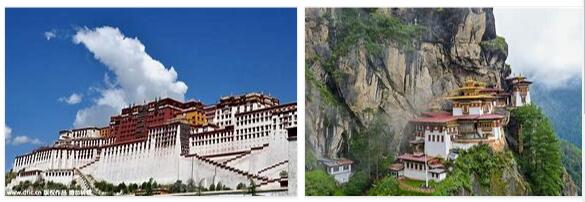Jokhang
Hundreds of butter lamps shimmer gently in the semi-darkness, Buddhist statues gently look down from their pedestals at believers, monks and pilgrims. To offer one’s offerings in the chapels of Jokhang once in a lifetime is the dream of many believers.
The Jokhang Temple in Lhasa is the most important in the country for the followers of Tibetan Buddhism. Thousands of Buddhists circle the entire complex every year. Adorned with jewels, the statue of Jowo Shakyamuni awaits the offerings of the Tibetans.
Study trips on the roof of the world
For the Tibetan culture, the Buddhist belief is a fundamental component. The rituals of their faith are firmly anchored in the traditional way of life between the peaks of the Himalayas. As part of a study trip to Tibet, intensive insights into this life in a rugged, yet fascinatingly beautiful mountain world will open up.
The temple complex dates from the seventh century. A gilded roof made of bronze tiles protects dozens of statues inside. Turning prayer wheels, the pilgrims walk along the walkway called the “Inner Path”.
Lhasa viewed from above
The roof of the Jokhang offers the visitor a breathtaking view, for which the trip to Tibet alone is worthwhile: on the Barkhor, the outer pilgrimage route around the temple, there is lively market activity. Beyond the Tempelhof, the view sweeps across Lhasa to the Potala Palace in the distance. On the horizon the mountain slopes rise steeply up to the clouds.
The sacred Manasarovar Lake
Lake Manasarovar is located in what is now Tibet in the People’s Republic of China. It is a special shrine for Buddhists and Hindus and is an important and well-known place of pilgrimage. The mythical lake is partly up to 77 m deep and has a size of 412 km².
A sea of colors and light
This huge freshwater lake with its huge, sapphire-blue water surface appears like a sea of turquoise and deep blue. It is an important destination for pilgrims, but it is also considered a very good place for rest and meditation for ordinary visitors. The Manasarovar Lake is a very clean body of water, the light blue of which casts a spell on everyone. Visitors can take the opportunity to take a dip in the cold water, while others can simply enjoy the deep silence and the breathtaking panorama.
A place of great spiritual importance
On the shores of Lake Manasarovar, brightly colored prayer flags flutter and every time they flutter, they send an auspicious prayer into the sky over Tibet, so that the wind carries the prayers all over the world. It is said that whoever bathes in the waters of Lake Manasarovar or drinks from it, their existence will be purified and their mind will be enlightened. Circumnavigating the big lake once, which pilgrims need about two to four days for, is supposed to clear the darkening of life and free people from their sins. For those who believe in this destiny, it is a place where one can attain enlightenment and tranquility.
Norbulingka
The former summer residence of the Dalai Lama
The Norbulingka is an extensive park and a magnificent palace west of the city of Lhasa in what is now Tibet. The area used to be used by the Dalai Lamas as a recreation area and summer residence. The Norbulingka, which translates as “Jewel Garden”, is now a museum that is open to the public. The park has an area of almost 40 hectares.
The moving story of Norbulingka
The Norbulingka was planned as the summer palace of the eighth Dalai Lama, but most of the buildings were not built until the reigns of the 13th and 14th Dalai Lama. The site of the complex used to be a willow grove, and when the air warmed up in spring and the willows began to bloom, the Dalai Lama would leave his official seat of government and move to his summer palace in a solemn procession. When the Chinese army attacked the city of Lhasa in 1959, the 14th Dalai Lama lived here. He was able to flee to India with his followers, but after the flight of the spiritual and secular leader, the Norbulingka was badly damaged in fighting.
From the summer palace to the museum
You can visit an anteroom, the audience room of the Dalai Lama, the bedroom, the meditation chamber, the rooms of the mother of the Dalai Lama and the reception hall with the beautifully designed golden throne. The abandoned rooms look very impressive, but also create a feeling of sadness, as they clearly show the reality of exile.
The best time to visit Norbulingka is during the summer months. If you are in Lhasa during the Festival of Worship of the Buddha in July or the Shoton Festival (“yogurt festival”) in August or September, you can have a picnic, admire performances of mask dances or traditional Tibetan operas. During these holidays, people come to Norbulingka in solemn clothing with tents and groceries and sing and dance all night long.
